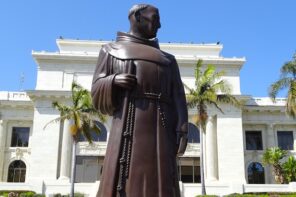I’m in the process of developing a new course on women and ministry at the Jesuit university where I teach. It almost goes without saying that I’ve been anticipating a slow, deliberate walk through the minefield of history, theology, and emotion related to the role of women in ministry roles in the Roman Catholic Church and other Christian traditions and the ways in which the Church Catholic/catholic has ministered to women. From longstanding debates about women’s access to ordained ministry and questions of conscience-driven choice with regard to contraception and abortion, to the Vatican rebuke of American women religious and the “Nuns on the Bus” tour this summer—which reached something of a crescendo with Sister Simone Campbell’s address to the Democratic National Convention—I’ve been working on ways to guide students over rocky terrain.
Into that fraught landscape came the news earlier this week that Karen L. King, a Harvard Divinity School church historian and expert on the controversial biblical figure, Mary Magdalene, had been given access to a papyrus fragment held by a private collector. The fragment includes the provocative phrases, “Jesus said to them, ‘My wife…’” and “…she will be my disciple.” What King has called the “Gospel of Jesus’ Wife” on generic rather than theological grounds, was extensively studied by experts on papyrus and the Coptic language in which it is written to assess its authenticity and date the fragment before King presented preliminary findings this week in Rome at a conference on Coptic studies. More testing is forthcoming, but there is a reasonable scholarly consensus that the papyrus, an apparent artifact of a late second-century Christian community somewhere in Egypt, merits further study.
These are among the salient facts of the discovery at this point, and scholars quickly began queuing up to weigh in on whether or not the fragment is authentic. But the more popular conversation has swirled around an issue to which King herself made clear the fragment was not able to speak: Was Jesus married? Was his wife the historically confused Mary Magdalene? Was she a full-fledged disciple? This historical questions cannot, of course, be answered on the basis of a tiny, incomplete scrap of text out of the context of a complete document and a community of authorship and reception.
But why let that stop us from speculating.
The Jesuit humorist James Martin was quick to reinforce the traditional Roman Catholic teaching on the marital status of Jesus: “It is more likely that Jesus was celibate.”
Offering a classic argumentum e silentio to support the magisterial argument from silence about Jesus’ purported celibacy, Martin explains that the Christian gospels, edited and selected over the early centuries of the Church by factions with varying investments in the matter, and which nowhere discuss Jesus’ sexuality—celibate, married, or otherwise—also nowhere discuss Jesus’ wife. Ipso facto, dipsy doodle, if the fragment is historically authentic, in it Jesus is not referring to the wife of Jesus. Or, we might ague based on the same evidentiary pile of nothing, it was written by the likes of those Gnostic heretics who churned out the Gospel of Mary [Magdalene]. Maybe both.
Of course, we can understand why a well-known Roman Catholic priest would be so eager to insist on the celibacy of Jesus, and it’s certain that many Catholic churchgoers will be raising the question this Sunday. So, let’s just assume that the affable chaplain to Stephen Colbert was merely tending to his most immediate flock—readers of the New York Times.
But the more challenging questions, which King does claim for her study of the fragment, are about historically-grounded, biblically-ambiguous notions of sexuality, marriage, and discipleship as they swirled around the early church and continue to do so among believers today.
It is not likely, that is, that we will ever definitively answer the question of Jesus’ marital status and the specific ministry status of women in his circle as he and his followers understood it. But there is abundant evidence, both in contradictions within the Bible as it was canonized in the late fourth century and from extra-biblical artifacts that show that women did have leadership roles from the earliest days of the Church, as both priests and deacons. The “Gospel of Jesus’ Wife” fragment adds to a bounty of evidence that women did hold both lay and ordained ministry leadership roles in the earliest Church and their status as such, as with the nuptial status of priests, has been a matter of ongoing debate and divergent practice throughout the history of the Church, however firmly Rome has believed it has spoken.
In this light, the questions that will stir again among my graduate students, and I suspect among many churchgoers generally, will likely not have much to do with the authenticity of the fragment and what it may or may not, in itself, say about the marital status of Jesus or the leadership status of women. Rather, they will be asking again to what exactly—if the Church continues to disregard the evidence of history and the voices of the faithful in engaging the world as it is and as it can be—are its current leaders listening?





